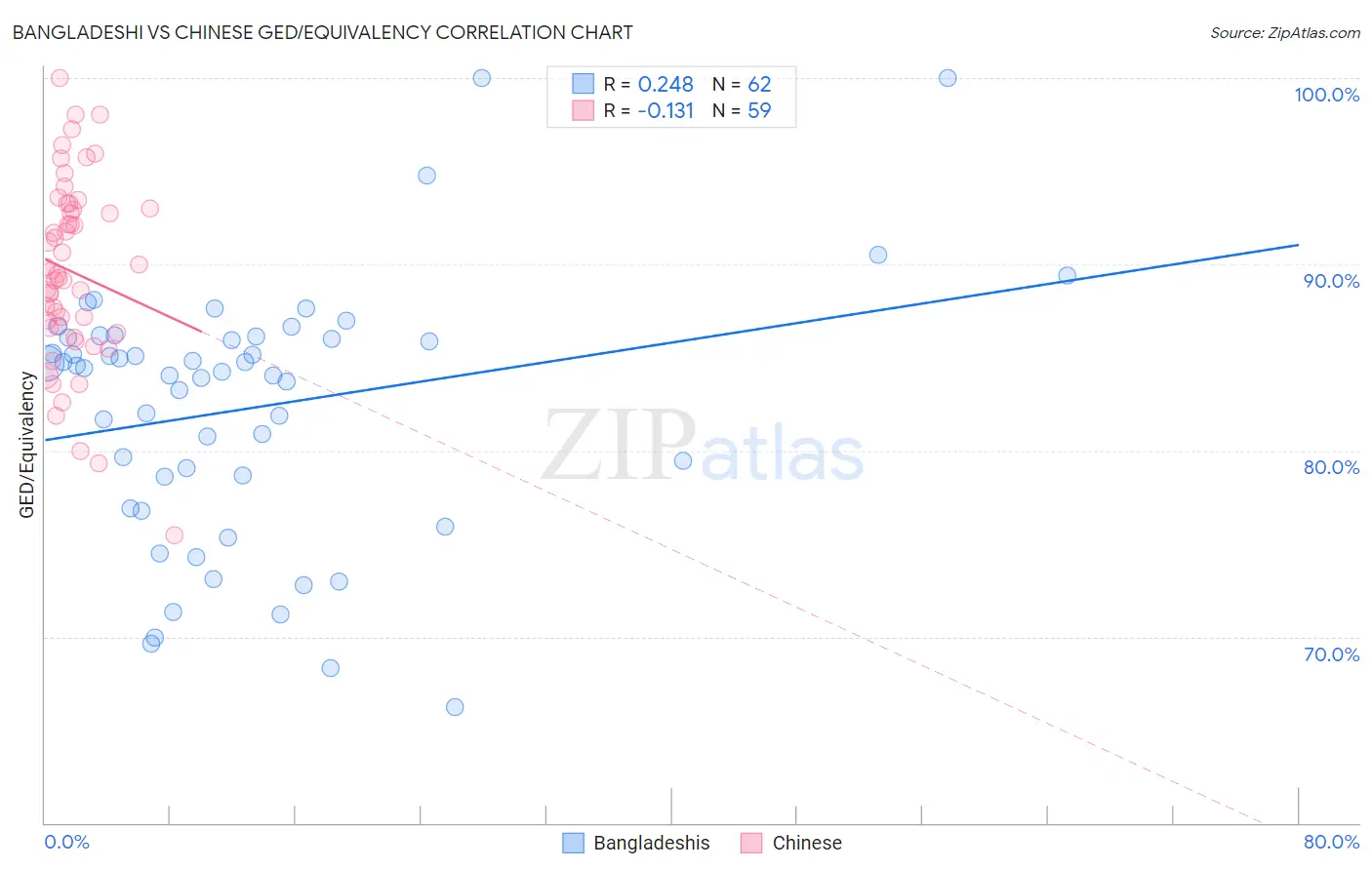Bangladeshi vs Chinese GED/Equivalency
COMPARE
Bangladeshi
Chinese
GED/Equivalency
GED/Equivalency Comparison
Bangladeshis
Chinese
83.1%
GED/EQUIVALENCY
0.2/ 100
METRIC RATING
264th/ 347
METRIC RANK
89.0%
GED/EQUIVALENCY
99.9/ 100
METRIC RATING
9th/ 347
METRIC RANK
Bangladeshi vs Chinese GED/Equivalency Correlation Chart
The statistical analysis conducted on geographies consisting of 141,450,108 people shows a weak positive correlation between the proportion of Bangladeshis and percentage of population with at least ged/equivalency education in the United States with a correlation coefficient (R) of 0.248 and weighted average of 83.1%. Similarly, the statistical analysis conducted on geographies consisting of 64,809,883 people shows a poor negative correlation between the proportion of Chinese and percentage of population with at least ged/equivalency education in the United States with a correlation coefficient (R) of -0.131 and weighted average of 89.0%, a difference of 7.2%.

GED/Equivalency Correlation Summary
| Measurement | Bangladeshi | Chinese |
| Minimum | 66.2% | 75.4% |
| Maximum | 100.0% | 100.0% |
| Range | 33.8% | 24.6% |
| Mean | 82.3% | 89.6% |
| Median | 84.3% | 89.4% |
| Interquartile 25% (IQ1) | 78.6% | 86.6% |
| Interquartile 75% (IQ3) | 86.0% | 93.0% |
| Interquartile Range (IQR) | 7.4% | 6.5% |
| Standard Deviation (Sample) | 6.9% | 4.9% |
| Standard Deviation (Population) | 6.8% | 4.9% |
Similar Demographics by GED/Equivalency
Demographics Similar to Bangladeshis by GED/Equivalency
In terms of ged/equivalency, the demographic groups most similar to Bangladeshis are Immigrants from Congo (83.1%, a difference of 0.010%), West Indian (83.1%, a difference of 0.010%), Kiowa (83.1%, a difference of 0.010%), Inupiat (83.1%, a difference of 0.020%), and Immigrants from Armenia (83.1%, a difference of 0.020%).
| Demographics | Rating | Rank | GED/Equivalency |
| Jamaicans | 0.4 /100 | #257 | Tragic 83.3% |
| Malaysians | 0.4 /100 | #258 | Tragic 83.3% |
| Immigrants | Vietnam | 0.3 /100 | #259 | Tragic 83.2% |
| Choctaw | 0.3 /100 | #260 | Tragic 83.1% |
| Inupiat | 0.2 /100 | #261 | Tragic 83.1% |
| Immigrants | Armenia | 0.2 /100 | #262 | Tragic 83.1% |
| Immigrants | Congo | 0.2 /100 | #263 | Tragic 83.1% |
| Bangladeshis | 0.2 /100 | #264 | Tragic 83.1% |
| West Indians | 0.2 /100 | #265 | Tragic 83.1% |
| Kiowa | 0.2 /100 | #266 | Tragic 83.1% |
| Trinidadians and Tobagonians | 0.2 /100 | #267 | Tragic 83.0% |
| Immigrants | Burma/Myanmar | 0.2 /100 | #268 | Tragic 83.0% |
| Hopi | 0.2 /100 | #269 | Tragic 83.0% |
| Immigrants | Jamaica | 0.2 /100 | #270 | Tragic 82.9% |
| U.S. Virgin Islanders | 0.2 /100 | #271 | Tragic 82.9% |
Demographics Similar to Chinese by GED/Equivalency
In terms of ged/equivalency, the demographic groups most similar to Chinese are Carpatho Rusyn (89.1%, a difference of 0.020%), Norwegian (89.0%, a difference of 0.040%), Eastern European (89.1%, a difference of 0.070%), Bulgarian (89.0%, a difference of 0.080%), and Thai (89.1%, a difference of 0.12%).
| Demographics | Rating | Rank | GED/Equivalency |
| Filipinos | 100.0 /100 | #2 | Exceptional 89.5% |
| Immigrants | Singapore | 100.0 /100 | #3 | Exceptional 89.3% |
| Iranians | 100.0 /100 | #4 | Exceptional 89.2% |
| Latvians | 100.0 /100 | #5 | Exceptional 89.2% |
| Thais | 100.0 /100 | #6 | Exceptional 89.1% |
| Eastern Europeans | 99.9 /100 | #7 | Exceptional 89.1% |
| Carpatho Rusyns | 99.9 /100 | #8 | Exceptional 89.1% |
| Chinese | 99.9 /100 | #9 | Exceptional 89.0% |
| Norwegians | 99.9 /100 | #10 | Exceptional 89.0% |
| Bulgarians | 99.9 /100 | #11 | Exceptional 89.0% |
| Lithuanians | 99.9 /100 | #12 | Exceptional 88.9% |
| Immigrants | Iran | 99.9 /100 | #13 | Exceptional 88.9% |
| Cypriots | 99.9 /100 | #14 | Exceptional 88.9% |
| Okinawans | 99.9 /100 | #15 | Exceptional 88.9% |
| Immigrants | Taiwan | 99.9 /100 | #16 | Exceptional 88.8% |